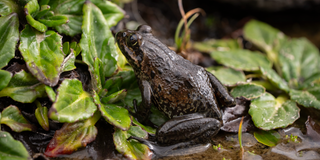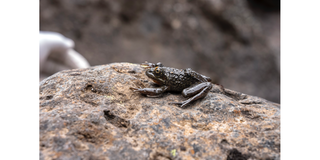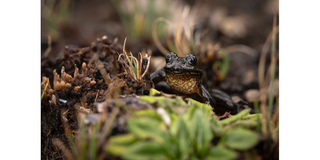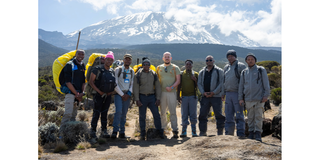The highest-living frog in Africa discovered on Mount Kilimanjaro

The discovered Amietia wittei—the highest-dwelling frog ever recorded in Africa—rests beside an alpine stream nearly 4,000 metres above sea level on Mount Kilimanjaro.
What you need to know:
The frog, first seen by a team from Altezza Travel, prompted immediate interest from researchers.
Kilimanjaro. A surprising splash of life startled a team of trekkers navigating the alpine heights of Mount Kilimanjaro.
At an elevation of 3,960 metres above sea level—where icy winds lash and the landscape appears lifeless—they spotted a tiny frog hopping near a stream.

The discovered Amietia wittei clings to a mossy rock, blending perfectly into its icy alpine surroundings.
Long thought unable to survive at such extremes, this amphibian’s presence marked a milestone in African herpetology.
The frog, first seen by a team from Altezza Travel, prompted immediate interest from researchers.
Until then, no amphibians had been documented above 3,000 metres in this region.
What began as a curious sighting quickly evolved into a scientific investigation.
In February 2025, a dedicated expedition led by the Tanzania Wildlife Research Institute (Tawiri), in partnership with Altezza Travel, returned to the upper slopes of Kilimanjaro.
Scientists Wilirk Ngalason Mroso, Shayo Adolph Felix, Juma Idd Kimera and Yoel Kitungul, accompanied by seasoned guides, surveyed four icy streams between 3,600 and 4,100 metres.

Perched at the edge of a glacial pool, the discovered Amietia wittei showcases nature’s resilience on Africa’s highest peak.
Their mission was to confirm the frogs’ presence and assess their ecological significance.
Among them was a renowned South African herpetologist, Prof Alan Channing, who joined the team to lead the taxonomic analysis.
Over five challenging days, the researchers found several frog populations thriving in small alpine pools—definitive proof that these cold-blooded creatures had carved out a niche at the roof of Africa.
Subsequent DNA analysis identified the species as Amietia wittei, or Witte’s River Frog.
While the species was already known to science, its discovery at such an altitude was unprecedented.
“We were stunned. This is now the highest-dwelling frog species recorded on the African continent,” said Prof Channing.
These frogs were found nearly 1,000 metres above their previously known range, making them not just a biological curiosity, but also a possible indicator of environmental shifts on Africa’s tallest mountain.

A team of scientists from Tawiri, Altezza Travel, and international partners conducted a high-altitude expedition on Mount Kilimanjaro, leading to the discovery of Africa’s highest-dwelling frog.
A mountain of surprises
The expedition’s lead guide, Mr Peter Lyamuya, was among the first to spot the frog.
With dozens of Kilimanjaro ascents to his name, he described the encounter as “one of my proudest moments. Nature still holds secrets, even in places we think we know.”
Guides and porters from Altezza Travel played a vital role, carrying research equipment, navigating the remote terrain, and assisting in frog collection—all under sub-zero conditions.
Although Kilimanjaro is one of Africa’s most visited natural landmarks, this discovery highlights the mountain’s often-overlooked biological richness.
“Finding frogs at that altitude is like discovering life on another planet—it’s truly astounding,” said Prof Channing.
An amphibian like no other
In recent years, scientists have uncovered a wave of new amphibian species. Seven new tree frogs were documented in Madagascar in 2024, while researchers in Tanzania’s Ukaguru Mountains found a ‘silent’ frog species that communicates using throat spines instead of sound.
But the Kilimanjaro frogs are unique. They were not hidden deep in an uncharted jungle, but thriving in one of the continent’s best-known tourist destinations.
Their survival in cold, oxygen-poor air—where temperatures drop well below freezing at night—demonstrates a rare and extreme form of adaptation.
Globally, fewer than ten frog species have been recorded above 4,000 metres. Until now, none had been found at such elevations in Africa.
“For a typically tropical animal to survive up there challenges what we thought we knew about amphibian ecology,” said one member of the research team, adding: “It’s like a frog climbed to the top of Africa and decided to stay.”
Fragile waters, rising threats
With the discovery comes responsibility. Scientists are now assessing the conservation needs of these highland amphibians, which face mounting environmental threats.
One pressing concern is pollution from trekking-related activities. Each year, tens of thousands of climbers ascend Kilimanjaro. Porters often wash utensils directly in mountain streams using soaps and detergents—small acts that add up over time.
“We observed frogs were absent in areas where washing had occurred,” said Tawiri’s Wilirk Mroso, adding. “Even minor pollution could be driving them away.”
Water scarcity is another looming issue. The research team noted a significant decline in stream flow, likely linked to climate change.
“Three of the five streams we surveyed dry up completely during the dry season,” added Mr Mroso.
For a frog whose tadpoles may require up to two years to mature in frigid waters, this could mean entire generations wiped out by prolonged drought.
Natural predators also pose a threat. Species such as herons, while native to the ecosystem, benefit from the reduced stream depth and cover, making it easier to prey on vulnerable tadpoles.
Protected, but not immune
There is, however, cause for optimism. The frogs’ habitat lies entirely within Kilimanjaro National Park (Kinapa), offering protection from logging, farming, and infrastructure development.
Yet researchers argue that legal protection is not enough.
To secure the frogs’ future, the team recommends tighter regulation of detergents and waste disposal, ongoing water quality monitoring, and improved environmental awareness among both trekkers and tour operators.
“This isn’t just about saving a frog—it’s about protecting the entire mountain ecosystem,” said Dmitry Andreichuk, expedition leader at Altezza Travel.
Frogs are widely regarded as bioindicators—organisms that reflect the overall health of an environment.
Their decline could foreshadow broader ecological damage affecting other wildlife and even human communities downstream.
“Protecting the frogs protects the streams. And protecting the streams protects us all,” said Prof Channing.
Many villages around Kilimanjaro rely on water from these mountain springs for drinking, agriculture, and daily needs. Cleaner water sources mean healthier communities.
Guides become guardians
For Mr Lyamuya and his colleagues, the discovery has reshaped their view of the mountain they’ve guided for years.
“This frog may be tiny, but its discovery sends a big message. We must protect its fragile home. In doing so, we also protect Kilimanjaro’s natural heritage,” he said.

A team of Tanzanian researchers carefully examines a frog habitat during the high-altitude expedition on Mount Kilimanjaro that led to the discovery of Africa’s highest-dwelling amphibian.
Tawiri and Altezza Travel expressed gratitude to Tawiri director general Dr Eblate Mjingo, Tanzania National Parks Authority (Tanapa), Conservation Commissioner, Mr Musa Juma, and Kinapa chief park warden, Ms Angela Nyaki, for supporting the expedition.
As word of the discovery spreads, it serves as a reminder: even well-trodden landscapes can still hold untold wonders.
The frogs of Kilimanjaro have leapt into the scientific spotlight, challenging assumptions and prompting fresh calls for conservation.
Their story is not only about survival—but stewardship. Of mountains, waters, and the delicate connections that sustain life.





